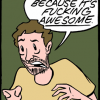what am trying to do is implementing Camera calss so I can walk and look on the world as follow:
#ifndef _CAMERA_H_
#define _CAMERA_H_
#include <glm\glm.hpp>
class Camera
{
public:
Camera();
~Camera();
void Update(const glm::vec2& newXY);
//if by = 0.0 it means, it will use the const Class speed to scale it
void MoveForward(const float by = 0.0f);
void MoveBackword(const float by = 0.0f);
void MoveLef(const float by = 0.0f);
void MoveRight(const float by = 0.0f);
void MoveUp(const float by = 0.0f);
void MoveDown(const float by = 0.0f);
void Speed(const float speed = 0.0f);
glm::vec3& GetCurrentPosition();
glm::vec3& GetCurrentDirection();
glm::mat4 GetWorldToView() const;
private:
glm::vec3 position, viewDirection, strafeDir;
glm::vec2 oldYX;
float speed;
const glm::vec3 up;
};
#endif
#include "Camera.h"
#include <glm\gtx\transform.hpp>
Camera::Camera()
:up(0.0f, 1.0f, 0.0), viewDirection(0.0f, 0.0f, -1.0f),
speed(0.1f)
{
}
Camera::~Camera()
{
}
void Camera::Update(const glm::vec2& newXY)
{
glm::vec2 delta = newXY - oldYX;
auto length = glm::length(delta);
if (glm::length(delta) < 50.f)
{
strafeDir = glm::cross(viewDirection, up);
glm::mat4 rotation = glm::rotate(-delta.x * speed, up) *
glm::rotate(-delta.y * speed, strafeDir);
viewDirection = glm::mat3(rotation) * viewDirection;
}
oldYX = newXY;
}
void Camera::Speed(const float speed)
{
this->speed = speed;
}
void Camera::MoveForward(const float by)
{
float s = by == 0.0f ? speed : by;
position += s * viewDirection;
}
void Camera::MoveBackword(const float by)
{
float s = by == 0.0f ? speed : by;
position += -s * viewDirection;
}
void Camera::MoveLef(const float by )
{
float s = by == 0.0f ? speed : by;
position += -s * strafeDir;
}
void Camera::MoveRight(const float by )
{
float s = by == 0.0f ? speed : by;
position += -s * strafeDir;
}
void Camera::MoveUp(const float by )
{
float s = by == 0.0f ? speed : by;
position += s * up;
}
void Camera::MoveDown(const float by )
{
float s = by == 0.0f ? speed : by;
position += -s * up;
}
glm::vec3& Camera::GetCurrentPosition()
{
return position;
}
glm::vec3& Camera::GetCurrentDirection()
{
return viewDirection;
}
glm::mat4 Camera::GetWorldToView() const
{
return glm::lookAt(position, position + viewDirection, up);
}and I update and render as follow :
void Game::OnUpdate()
{
glLoadIdentity();
glClear(GL_COLOR_BUFFER_BIT | GL_DEPTH_BUFFER_BIT);
glUniformMatrix4fv(program->GetUniformLocation("modelToViewWorld"), 1, GL_FALSE, &cam.GetWorldToView()[0][0]);
}
void Game::OnRender()
{
model->Draw();
}where the Vertix shader:
#version 410
layout (location = 0) in vec3 inVertex;
layout (location = 1) in vec2 inTexture;
layout (location = 2) in vec3 inNormal;
uniform mat4 modelToViewWorld;
void main()
{
gl_Position = vec4(mat3(modelToViewWorld) * inVertex, 1);
}but what is happening is am moving/rotating the Model it's self not the camrea around it . what am doing wrong here?










